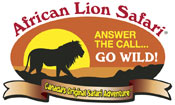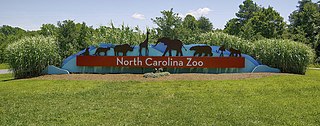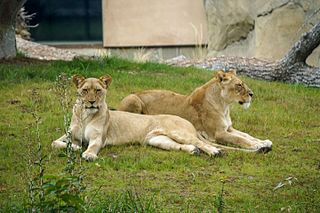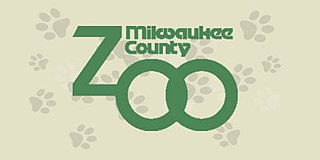The Saint Louis Zoo, officially known as the Saint Louis Zoological Park, is a zoo in Forest Park, St. Louis, Missouri. It is recognized as a leading zoo in animal management, research, conservation, and education. The zoo is accredited by the Association of Zoos and Aquariums (AZA). Admission is free based on a public subsidy from a cultural tax district, the Metropolitan Zoological Park and Museum District (ZMD); fees are charged for some special attractions. A special feature is the 2 ft narrow-gauge Emerson Zooline Railroad with passenger trains pulled by Chance Rides C.P. Huntington locomotives that encircle the zoo, stopping at the more popular attractions.

The Montreal Biodome is a museum of enclosed ecosystems located at Olympic Park in the Mercier–Hochelaga-Maisonneuve borough of Montreal, Quebec, Canada, that allows visitors to walk through replicas of four ecosystems found in the Americas.

The Houston Zoo is a 55-acre (22 ha) zoological park located within Hermann Park in Houston, Texas, United States. The zoo houses over 6,000 animals from more than 900 species. It receives around 2 million visitors each year and is the second most visited zoo in the United States, surpassed only by the San Diego Zoo. It is accredited by the Association of Zoos and Aquariums (AZA). The zoo has been operated by the non-profit corporation Houston Zoo since 2002, and was previously operated by the City of Houston.

African Lion Safari is a family-owned safari park in Southern Ontario, Canada, located between the cities of Hamilton and Cambridge, located 100 kilometres (62 mi) west of Toronto. Guests may tour seven game reserves, with a total area of about 740 acres, on tour buses or in visitors' own vehicles, where animals roam freely in contained areas. Accompanying the game reserves is a walking section where exotic birds and primates, as well as the park's herd of Asian elephants, are on display.

Audubon Zoo is an American zoo located in New Orleans, Louisiana. It is part of the Audubon Nature Institute which also manages Audubon Aquarium, Audubon Louisiana Nature Center, Freeport-McMoran Species Survival Center, Audubon Park, and Audubon Coastal Wildlife Network. It covers 58 acres (23 ha) and is home to over 2,000 animals. It is located in a section of Audubon Park in Uptown New Orleans, on the Mississippi River side of Magazine Street. The zoo and park are named in honor of artist and naturalist John James Audubon who lived in New Orleans starting in 1821.

The Wilder Institute/Calgary Zoo is located in Bridgeland, Calgary, Alberta, Canada, just east of the city's downtown and adjacent to the Inglewood and East Village neighborhoods. It is accessible via Calgary's C-Train light rail system, by car via Memorial Drive, and by bicycle and footpath via the Bow River pathway. A large portion of the zoo is located on St. George's Island in the Bow River.

The North Carolina Zoo, formerly the North Carolina Zoological Park, is a zoo in Asheboro, North Carolina, housing 1,700 animals of more than 250 species, primarily representing Africa and North America. It is one of two state-supported zoos in the United States, with the other being the Minnesota Zoo. With 500 acres (2.0 km2) developed, it is the world's largest natural habitat zoo. The North Carolina Zoo is a part of the North Carolina Department of Natural and Cultural Resources.

The Fresno Chaffee Zoo is a zoo in Roeding Park in Fresno, California covering 39 acres and housing over 190 species. Its attractions include Stingray Bay, Dino Dig, Valley Farm, Sea Lion Cove, African Adventure, and Ross Laird's Winged Wonders Bird Show. The zoo is accredited by the Association of Zoos and Aquariums (AZA) and is a member of the World Association of Zoos and Aquariums (WAZA).

The Pittsburgh Zoo & Aquarium is a zoo and aquarium in the United States, one of only six major zoo and aquarium hybrids in the United States. Located in Pittsburgh, Pennsylvania's Highland Park, the zoo sits on 77 acres (31 ha) of park land where it exhibits more than 4,000 animals representing 475 species, including 20 threatened or endangered species.

The Edmonton Valley Zoo is a zoo located in Edmonton, Alberta's river valley. The Edmonton Valley Zoo is owned and operated by the City of Edmonton and is open 364 days a year, closing only on Christmas. The zoo is currently accredited by Canada's Accredited Zoos and Aquariums and is one of three accredited zoos in Alberta.
The Chattanooga Zoo at Warner Park is a 13-acre (5.3 ha) zoological park located in Warner Park in Chattanooga, Tennessee. The zoo was established in 1937 by the City of Chattanooga with the construction of two 4 by 6 feet cages for rhesus monkeys. The zoo has been accredited by the Association of Zoos and Aquariums (AZA) since 1998.

The Rosamond Gifford Zoo at Burnet Park is an AZA zoo in Syracuse, New York. It is owned and operated by Onondaga County Parks with support from the Friends of the Rosamond Gifford Zoo. The zoo is home to more than 900 animals representing 216 species on 43 acres (17 ha). Some of the more popular animals include Asian elephants, Humboldt penguins, Amur tigers, a Komodo dragon and the only Giant Pacific octopus exhibit in Central New York. The zoo opened a new Animal Health Center in 2022 that is the largest zoological medical center in New York state outside of the Bronx Zoo.

Assiniboine Park Zoo is a Canadian zoo facility located in the west end of Assiniboine Park in Winnipeg, Manitoba, Canada. Established in 1904, Assiniboine Park Zoo is managed by the Assiniboine Park Conservancy. It holds accreditation from the Canadian Association of Zoos and Aquariums and the Association of Zoos and Aquariums.
Canada's Accredited Zoos and Aquariums is an accreditation and advocacy organization representing zoos and aquariums within Canada. The organization states that its member zoos and aquariums care for more than 100,000 individual animals representing over 2000 species of wildlife, observed by an estimated 11 million visitors each year. The organization is a member of the International Union for Conservation of Nature and the World Association of Zoos and Aquariums.

Austin Zoo is a non-profit rescue zoo and located in southwestern unincorporated Travis County, Texas, United States, west of Austin. The zoo is accredited by the Zoological Association of America.

Niabi Zoo is a public Zoological Park in Coal Valley, Illinois, serving the Quad Cities Area. This 40 acre zoo is nestled inside its 287 acre forest preserve. The exploration of this picturesque setting guides guests through the discovery of more than 600 animals representing nearly 200 animal species from around the world. Niabi Zoo is open for general admission April–October annually and offers robust education and outreach programs year round.

The Milwaukee County Zoo is a zoo in Milwaukee, Wisconsin, operated by the Milwaukee County Parks Commission and is accredited by the Association of Zoos and Aquariums. The zoo averages about 1.3 million visitors a year. The zoo houses 3,100 animals from 350 species and covers an area of 190 acres (77 ha). The zoo is noted for the second birth of polar bears and siamangs in captivity and for their locally famous gorilla Samson, who lived from 1950 to 1981 and whose bones are now on display at the Milwaukee Public Museum. During World War II, a celebrity animal of the zoo was Gertie the Duck and her ducklings. The zoo is also home to one of the largest group of bonobos in one location outside their native Democratic Republic of the Congo, and has two cheetahs from the National Zoo in Washington, DC.
The Zoo Sauvage de St-Félicien is one of the largest zoos in the province of Quebec. Located in Saint-Félicien, the zoo is dedicated to wildlife conservation of the boreal climate and is managed by The Centre for Conservation of Boreal Biodiversity inc.

Bramble Park Zoo is located in Watertown, South Dakota. Open since 1912, the zoo comprises 15 acres (6.1 ha) with approximately 500 animals representing 130 different species. It is the second-largest zoo in South Dakota. The zoo is open year-round and takes extra steps to keep animals safe during South Dakota winters.


















